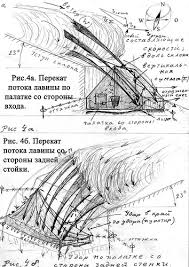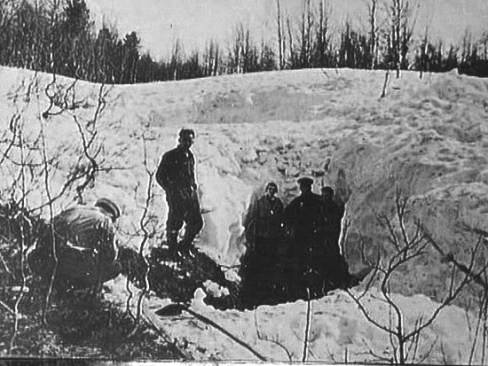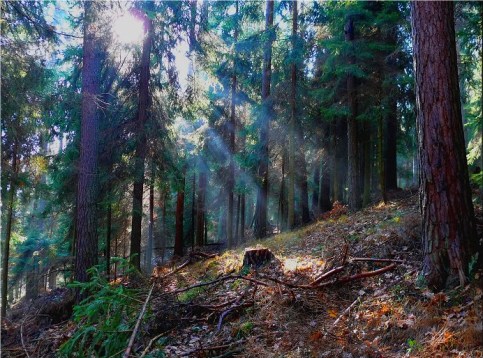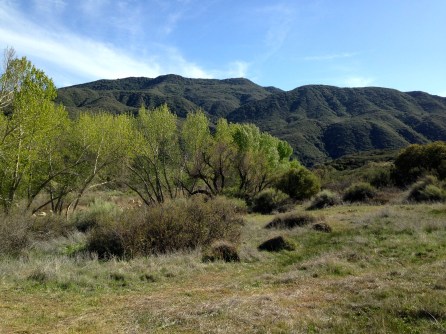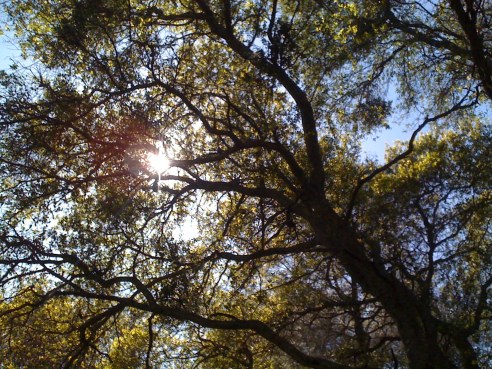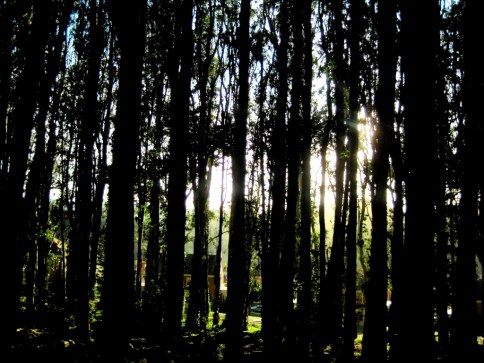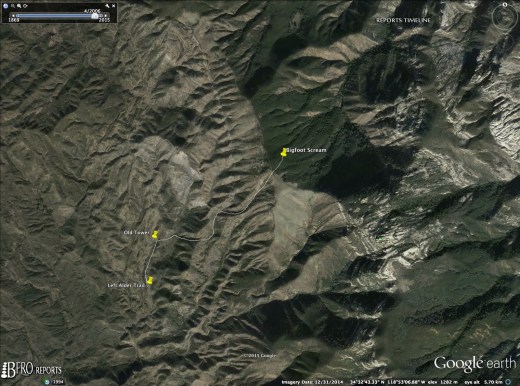That’s the rumor, you know. It’s been around for centuries. Though Native American’s often relate Bigfoot as a nocturnal, petty trickster who steals salmon, there are also legends of hairy devils with evil intent.

The Shampe of Choctaw fable, Ts’el’eni, the woodman of Athabaskan’s in Alaska, the Boqs of the Bella Coola, and Tsiatko, Stick Indians of Salish legend in the Pacific Northwest are a few examples. These big hairy creatures were known for stealing women and children, and eating people.
The Windigo, known to many tribes, is associated with evil. In times of famine, it ate human flesh and forever has a taste for it. There are also the Teihiihan, the little cannibals of Cheyenne and other tribal lore, described as something like a dwarf Bigfoot that entices children to play – and eats them.
Hopi believe Bigfoot is a harbinger of strife and doom. He shows himself to fellow man as a message that human behavior has strayed from the creator’s plan, and an accounting is coming due.

It’s not a cannibal unless it’s human. Otherwise it’s just another predator. Cannibal means a particular type of predator far more chilling to contemplate. The fact Native Americans call it cannibal betrays their belief in what it is. It’s the hairy man of the forest, a brother tribe of people.
Everyone has opinions, including a majority who outright deny its existence. But if you believe in the creature, you’re probably on a spectrum of opinion that runs from a big, relic ape, to a close cousin of mankind. Perhaps an archaic race similar to Neanderthal, or even a hybrid race that interbred with us.
Personally, I suspect they are relic hominids evolved from the same branch of genetic tree we are from. Shave Patty, the Bigfoot in the famous Patterson-Gimlin film, put lipstick and a dress on, and she’d have luck getting picked-up at the Bashful Bandit, my local biker bar.
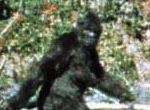
That seems to be the way Native Americans think about Sasquatch. They are the wild people of the woods, not another animal. They are feared and respected, and not to be allowed near children. They are not something to go looking for.
Enter the ancestors of mad Englishmen. Have you noticed Bigfoot hunters are usually white people? Non-believers account this to the ignorance of white trailer-trash folk, like me, who prefer a walk in Nature to working off the Mercedes payment all day.
This makes no sense to me. I’ll believe an outdoors man about the woods, no matter what the armchair people say. I think it’s because I belong to the only race in denial about Bigfoot.
Genetics experts say non-African people carry around 4% Neanderthal DNA, whereas Africans have hardly any. Maybe there is something dark in the Caucasian past we’re still dealing with. Perhaps that is why it’s existence is so vehemently denied by urbane people who consider themselves the pinnacle of civilization. The realities of the past are too uncomfortable to think about.
One reason Bigfoot fascinates many people is the idea humans and Neanderthal coupled in Europe in the distant past. And in Asia and Melanesia, DNA shows that people slept with Denisovan’s. The term ‘slept with’ is probably not accurate. Rape in the woods is more likely.
It points to a past when catastrophe decimated the population. There have been planet-wide catastrophes that nearly wiped life away, and the human race was reduced to small groups of survivors.
For life to go on, there had to be compromises. Brutal as it seems, there had to be cross-breeding. Perhaps forcibly and uninvited, but necessary nevertheless. It’s even believed cross-breeding bolstered the human immune system, giving us immunity to some disease.
So if there is the remnant of Neanderthal and Denisovan in the gene pool, that means at one time there were people born of interbreeding that had a fifty-fifty blend. Over time those individuals bred with other humans and the gene pool became diluted. Now there is a remnant of their DNA still carried in our blood.
But the corollary must also be true. Some of those hybrid babies were raised by surviving Neanderthal and Denisovan tribes. They would have bred in those communities, diluting the human gene. There must have been a hybrid being whose race was much less human. A feral race with more DNA of the ‘other thing.’
One can imagine they would be smart enough to survive. Smart enough to use rudimentary tools and even communicate. They could have come from Europe and Asia to populate the New World alongside human beings.
One could also imagine they were hunted mercilessly for indiscretions in the past. Nothing puts a man into fight mode faster than someone stealing his wife and eating his children. They would have been attacked and chased into hiding, like so many Hollywood bigwigs. They would have been the Harvey Weinstein of the time, rightfully shunned for predatory sexual behavior. Harvey even looks Neanderthal, come to think of it.
They got away with it for awhile, when calamitous weather, pestilence and famine decimated life. Survival meant taking what was needed wherever it was available, and the bigger and stronger hominids had the upper hand. Humans didn’t choose to be the wives, or the dinner for their ‘brother’ tribe. But humans had to wake-up at some point and say, “enough!” The Neanderthal and Denisovan would have been hunted down and made to account.
Feared, hunted and killed, and smart enough to understand their persecution, the remnants of those races hid from the enemy. Now they watch and keep track of us when we enter their territory, but like pedophiles and creeps, know better than to show themselves. Except when opportunity allows instinct to take over and satisfy a nasty, old habit.
Native people aren’t the only ones to have these legends, We all do, regardless of race. My people have just sanitized the stories and called them fairy tales to discredit them, but like all stories they begin from a grain of truth. Werewolves and boogeymen, giants and little people have origins of truth in the distant past. Horrible truths.
What happens in the mountains seems to bear this out. People go missing, without rhyme, or reason, never to be seen again. These disappearances have a pattern that is disturbing. David Paulides is an ex-cop and writer who documents strange and inexplicable disappearances in the National Forests.

Small children are found miles from where they vanish, across rugged, mountain country. People disappear while companions are just a few feet away. Experienced outdoors men take a walk and never come home. The typical profile is the last person on the trail, a child who wanders out of sight, or a solo hiker.
The disappearances often occur near a boulder field, rocky pinnacle, or cliff. As I’ve experienced myself, these are hangouts for Bigfoot. They also occur just prior to storms. Maybe an impending storm is a trigger. The blood rises with electricity in the air. A storm also provides cover – a better opportunity to get away.
Dogs trained for tracking can’t find them. Whatever scent they pick-up seems to create fear, and they refuse to track. Some lay down and whimper.
The mountain ranges I frequent have occurrences recorded that fit the profile. The camp host at one of my favorites called it “the last mountain in Arizona,” meaning it’s not overrun by anybody. Well it is, because there are billions of dollars worth of telescopes up there, but the astronomers keep to themselves, fenced inside the observatory. Otherwise, locals go there to hunt and camp, there are a few backpacking trails, and a smattering of cabins, but that’s all.
Many of the locals who go there, both Native American and otherwise, know of the presence of Bigfoot. Reports of intimidation are disturbing. People hear trees snapped in anger in the darkness at the edge of their campsites. Campers get pounded awake with blows that leave dents in the walls of their travel trailers. They hear guttural, unintelligible talking in some jabberwolky language. And there is howling at night.
I listened to howling that sounded like a cage of monkeys fighting a lion. Deep growls and grunts accompanied chimp-like squealing. It was a night of full moon at an elevation far above coyote country. It wasn’t coyote’s.
A few years ago, a woman reported to be mentally disabled walked just a hundred yards behind her family near a campsite in an adjacent mountain range. She disappeared without a trace within sight of her family, who were watchful because of her handicap. She vanished in a brief moment when they turned their attention away. And not a trace could be found. There was no trail, or track to follow.
The prior year, another woman, middle aged, camped with a group of people she didn’t know well. She’d been invited by a friend, but she wasn’t a regular in the group. As they partied around the campfire one evening, she left on her own to watch the sunset from rocky cliffs about a quarter-mile away. The cliffs overlooked a canyon named Hell’s Hole.
This is another common theme. Sightings and disappearances happen in locations with demonic names. One has to wonder why these places were named that way in the first place.
Of course, she was never seen again. Her belongings were left in her tent and no sign of her could be found. The searchers used cadaver dogs, lowered by rope to find her body in the cliffs below, because it seemed that was the only way she could have gone. They found nothing and the mystery remains.

From those same mountains, another story may shed light on what happens. It comes from an elderly woman who camped there with her parents as a little girl. She says she was six years old at the time, so this occurred in the sixties.
She sat on a log in the woods in sight of her parents when she heard something behind her. She turned around to see a big, black creature behind a tree. It was creeping up on her, she said, crawling from tree to tree and hiding behind logs. She thought it was a bear, until it stood up and she saw its face looked human. She ran to her parents and got away, her parents unaware of anything.
I came upon the trunk of a large tree hung upside down, cradled in the branches of another, with other trees leaned against it tee-pee fashion. I studied it trying to fathom if it could have happened naturally. It didn’t seem plausible.
As I scouted around the area, a path, or game trail led through brush, and I followed it a few yards to where it came to a boulder outcrop. As I reached the outcrop, I heard children playing, and realized it overlooked a campsite. The campsite was down the canyon, maybe five hundred feet below.

When I climbed onto the rocks, I was met with rock clacks. Something began tapping a substantial rock against another, warning me away. It tapped repeatedly, and not with a little pebble that a squirrel, or bird could pick up. It was a rock I’d gauge as big as my hand. I turned around and left, with the creepy realization that whatever clacked the rock was sitting in that boulder outcrop watching the kids play below.
In every instance I’ve seen, their trails lead uphill to natural lookout sites, usually at large granite outcrops. A ridge, or mountain top with a cap of rock that overlooks a campsite, or roadway is a likely spot.
When I have approached such areas, I have several times heard whoops. On one occasion, crossing a meadow towards an outcropping of boulders, there was a distinct whoop from the treeline to my right, and an answering whoop from the boulders. They were communicating a warning I was coming.
The interesting thing is that I parked my truck and fiddled around next to it for several minutes before I started walking towards the boulders. The whoops came only after I’d left the road and committed across the field. I’m sure the lookout could see me the whole time, but didn’t alarm until I started their way.
They watch us. They hang out in the rocks and trees and watch every move we make. They see us coming as soon as we start. They stay hidden and keep their distance. If we approach they fall back. Only if you keep invading their area do they start clacking rocks, or throwing them. To my knowledge, I’ve never had a rock thrown at me, although a pine cone did hit the car from a clear blue sky once.
Sightings of Bigfoot most often occur on roadways. It’s their biggest vulnerability. We’ve criss-crossed the land with big swaths naked of trees. Where there are trees, the Mountain Devil can’t be seen, except for the occasional glimpse, or surprise encounter. It’s rare they are surprised, but they have to cross roads.
Away from the trails and roads, in areas overgrown with underbrush, beneath peaks and ridges, where dead trees lean against each other, and there are rocky outcrops, and boulder fields – that is where they live. To enter is to experience them watching you, hear their whistles, whoops and clacks, and find their scuffs and footprints.
I filmed the following clip at Hell’s Hole, the location where the woman vanished. You’ll see several things in the video.
First, the trail was blocked every hundred yards, or so with broken trees. I was entering an area that had been closed all winter, and just reopened. I knew from the prior year it was a hot spot, where campsites coincide with access to a creek and one of their trails.
The further I went down the trail, the more trees I found felled, and the more obstacles blocked my way. It was as if, after the roads were closed and people had left for the season, they went-off on the campsite and road, tearing down trees in the hope maybe it would keep people from coming back.
At first, I maintained skepticism. The snows and winds of winter could have knocked the trees down. The further I went, however, the more apparent it became there was more than wind and snow pack at work.
On the way, I found a footprint. The toes impressed perfectly in the mud, but the heel landed in foliage making it hard to judge its length. It was at least twelve inches, but might have been as much as fourteen. It’s width was half-again the width of my bare foot – five inches, or more, in an area I had trouble walking in high boots. The ground was covered in brambles and broken trees. You can watch the video and judge for yourself if a human would walk barefoot in that country.

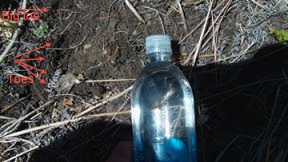
I followed what I suspected was a track they’d made. The ground was covered in fallen trees, browning ferns and broken twigs. Through it all, there was a distinct trail of steps, like post-holes in the dry ferns that left them broken down. The footprint appeared along the track in a rare patch of bare soil.
I had no plaster, which is a shame because I think it would have cast very well. I placed a water bottle along the edge of the print with the cap resting inside for scale. The print was flat, with a hint of a rise just left of the bottle cap that may have been at the mid-tarsal break. The toes prints are seen, with the big toe splayed away from the others.
A mid-tarsal break, and the ability to splay toes for balance, is characteristic of Bigfoot prints according to Dr. Grover Krantz, and Dr. Jeff Meldrum, both qualified experts in the subject. The pictures I took are not good as the mid-day sun beat straight down, making it impossible to keep shadows away, or see what I was framing.
The tracks led to the boulders above Hell’s Hole, the very place I was I was heading. The same place searchers lowered cadaver dogs to look for the missing woman. I had Ginger with me. She almost never barks, and only growls when she means business. She started growling almost the moment we reached the boulders. At the same time I heard a repetitive knock on wood. Knock-knock…knock-knock-knock. Knock-knock…knock-knock-knock.
This is on film in Part 2, but the knocking isn’t picked-up by the camera. It wasn’t the machine-gun rata-tat-tat of a woodpecker, but a slow and precise rhythm, like keeping time with a tune. Ginger refused to follow me any further in that direction. She stood her ground and growled.
I don’t know any normal forest animal that makes a knock like that. I had the feeling the playful sound was meant to entice me. Part of me wanted to go find the source, even though Ginger was growling. I couldn’t put the leash on and drag her, because there were too many trees broken down. I had to let her free to run her own obstacle course, but she refused to follow me.
We stayed long enough to take some film and left. I didn’t feel threatened. In fact, after a few minutes I felt whatever was making the knocks was gone. On the way out, though, I heard a solid wood-knock from a different direction.
It’s at this point I generally turn around, anyway. If I hear knocking, or whoops, I don’t go further. I know that won’t get me a photo op, but there is something about intruding where you’re not wanted. To be a paparazzi, even a Bigfoot paparazzi, is to be a cad, intruding on others privacy for the hope of a photo to sell.
Besides, I don’t want my head torn-off.
Interesting Resources:
Rise of the Warrior Apes … new perspective on our not-so-nice cousins, the chimpanzee.
From Discovery UK
Tolkien’s World – Cousin Species…
Update: They are smarter than you think…Can Great Apes Read Your Mind? from “The Conversation“
We shared the planet with pre-modern humans…Science Daily …Red Deer Cave People…less than 14,000 years ago.
Homo Floresiensis…17,000 years ago – hobbits!
Neanderthal…Denisovan…30,000 to 70,000 years ago. “The Truth Behind the Neanderthal Case“…a good documentary. Professor Tom Higham…”When Neanderthals and Modern Humans Meet” lecture at University of Oxford.
New genetic data on aboriginal Australian’s…Mystery ancient human ancestor found in Australasian family tree
What were they like…Super Predators?
What are they like…1967…”Patterson-Gimlin“…the full Munn’s Report.
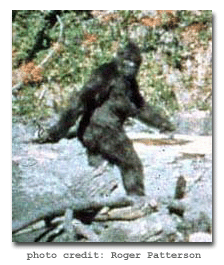
Documentary: Stranger than Fiction – “The Patterson Film”
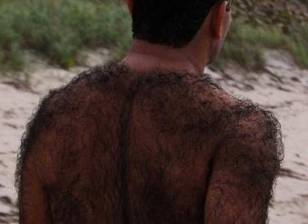
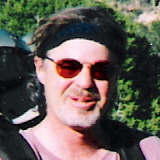
For the price of covfefe…
Please leave a tip to support The Daily Plasma.
$2.00
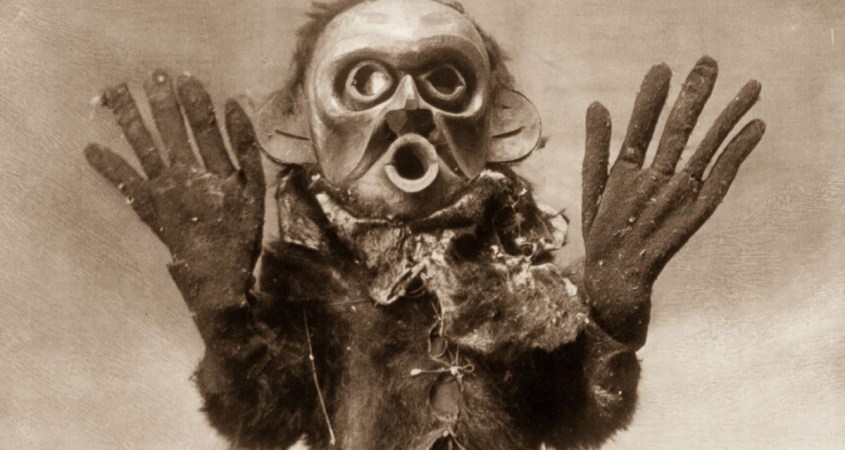
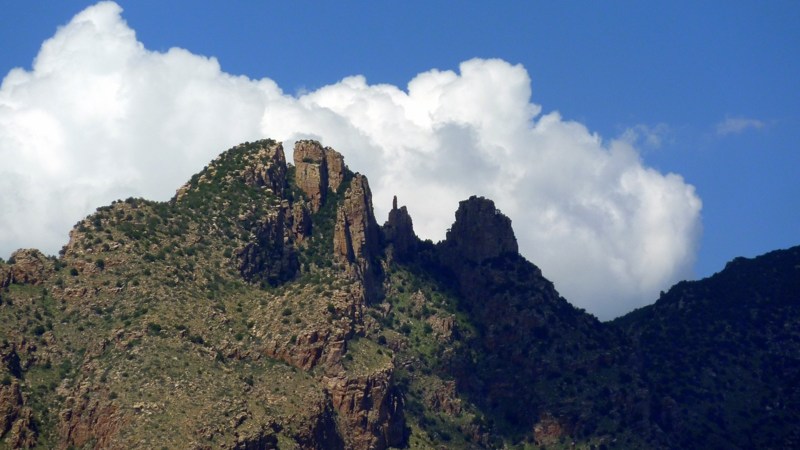
 The eastern sea is the Chihuahua Desert. I liken it to the Sargasso Sea – grasses on swells of rolling land with volcanic protrusions scattered here and there. It’s breezy and bucolic, an extension of the plains where antelope and buffalo once thrived. From West Texas to Arizona, and deep into Mexico, Chihuahua steams with thunderstorms in the summer, glazes with frost in the winter, and is a crystal cocoon of green grass and warmth in the Spring and Fall.
The eastern sea is the Chihuahua Desert. I liken it to the Sargasso Sea – grasses on swells of rolling land with volcanic protrusions scattered here and there. It’s breezy and bucolic, an extension of the plains where antelope and buffalo once thrived. From West Texas to Arizona, and deep into Mexico, Chihuahua steams with thunderstorms in the summer, glazes with frost in the winter, and is a crystal cocoon of green grass and warmth in the Spring and Fall. The western sea is the Sonoran. It’s an overgrown jungle of desert, if there ever was one. Wetter than a desert should be, it teems with botanical danger. Cholla, Prickly Pear, Barrel, Occatillo, and the most grand succulent of all, Saguaro, wear cloaks of surgically sharp needles. Even the trees, Palo Verde and Mesquite, have thorns.
The western sea is the Sonoran. It’s an overgrown jungle of desert, if there ever was one. Wetter than a desert should be, it teems with botanical danger. Cholla, Prickly Pear, Barrel, Occatillo, and the most grand succulent of all, Saguaro, wear cloaks of surgically sharp needles. Even the trees, Palo Verde and Mesquite, have thorns. The mountains are the thing, though. They are the way birds and mammals hopscotch the way across dry, desert seas from the Sierra Madre in Mexico, to the Colorado Plateau. They are islands, where summits rise to ten thousand feet, covered in Ponderosa Pine, Douglas Fir and Aspen. Between the peaks and desert floor, environments layer by elevation. Chihuahuan grasslands overlay foothills of Saguaro forests. Canyons sprout sycamore and cottonwood groves. Juniper, Oak and Pinion stand in mid-layers with caps of forested woods with Canadian winters.
The mountains are the thing, though. They are the way birds and mammals hopscotch the way across dry, desert seas from the Sierra Madre in Mexico, to the Colorado Plateau. They are islands, where summits rise to ten thousand feet, covered in Ponderosa Pine, Douglas Fir and Aspen. Between the peaks and desert floor, environments layer by elevation. Chihuahuan grasslands overlay foothills of Saguaro forests. Canyons sprout sycamore and cottonwood groves. Juniper, Oak and Pinion stand in mid-layers with caps of forested woods with Canadian winters. There are deep cuts in its stacked layers of rock that bear the signature of lightning. Sharp angled, lightning-bolt crevasses shoot up rock faces, their floors exposing dykes of quartz veined rock with a grain at cross pattern to the surrounding cliffs. In other areas, features of precisely the same shape form on soil, the quartz rock replaced with sediments of starkly different color where plants won’t grow.
There are deep cuts in its stacked layers of rock that bear the signature of lightning. Sharp angled, lightning-bolt crevasses shoot up rock faces, their floors exposing dykes of quartz veined rock with a grain at cross pattern to the surrounding cliffs. In other areas, features of precisely the same shape form on soil, the quartz rock replaced with sediments of starkly different color where plants won’t grow.
 The hike is in the Chihuahua ecological zone. It’s spring and the grasses blossom with color. It’s also warm and more buggy than normal. You’ll hear me spitting and swatting gnats quite a bit.
The hike is in the Chihuahua ecological zone. It’s spring and the grasses blossom with color. It’s also warm and more buggy than normal. You’ll hear me spitting and swatting gnats quite a bit.






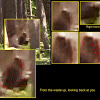
 Arizona isn’t the first place people think of when Bigfoot is the subject. This is one paradigm people should get over. They are not isolated to the Pacific North-West; the Cascades, the Rockies, or this, or that…they are closer than you think.
Arizona isn’t the first place people think of when Bigfoot is the subject. This is one paradigm people should get over. They are not isolated to the Pacific North-West; the Cascades, the Rockies, or this, or that…they are closer than you think. The term “
The term “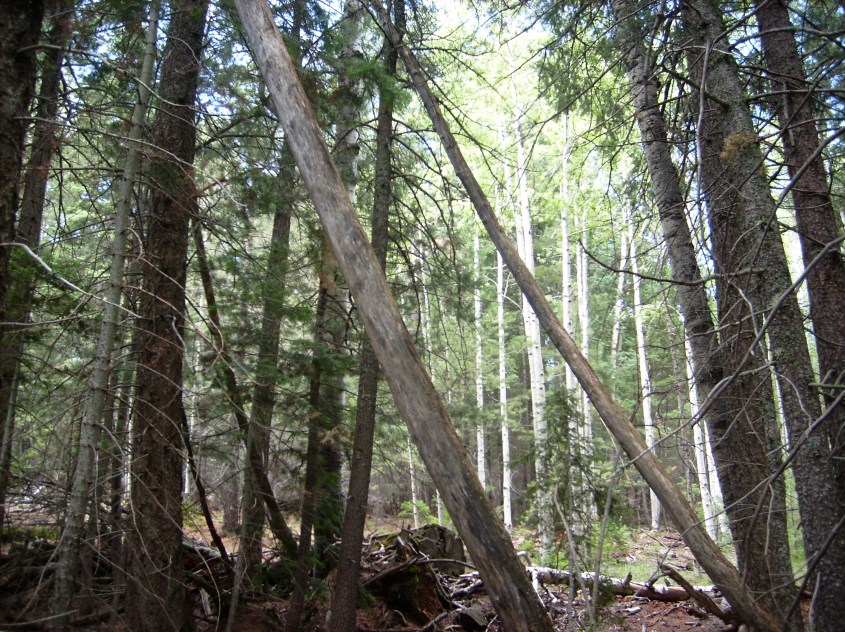 My technique is simple. I go light and alone except for my dog. I hike straight up a path of tree leans, quickly and quietly. I choose trails that lead a short distance to a ridge, or peak, where there is likely to be evidence of their presence. There is also the possibility of an encounter.
My technique is simple. I go light and alone except for my dog. I hike straight up a path of tree leans, quickly and quietly. I choose trails that lead a short distance to a ridge, or peak, where there is likely to be evidence of their presence. There is also the possibility of an encounter.


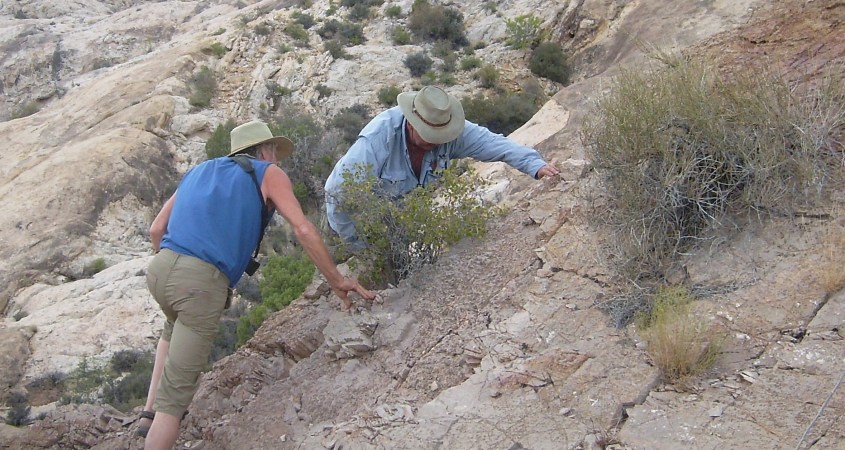





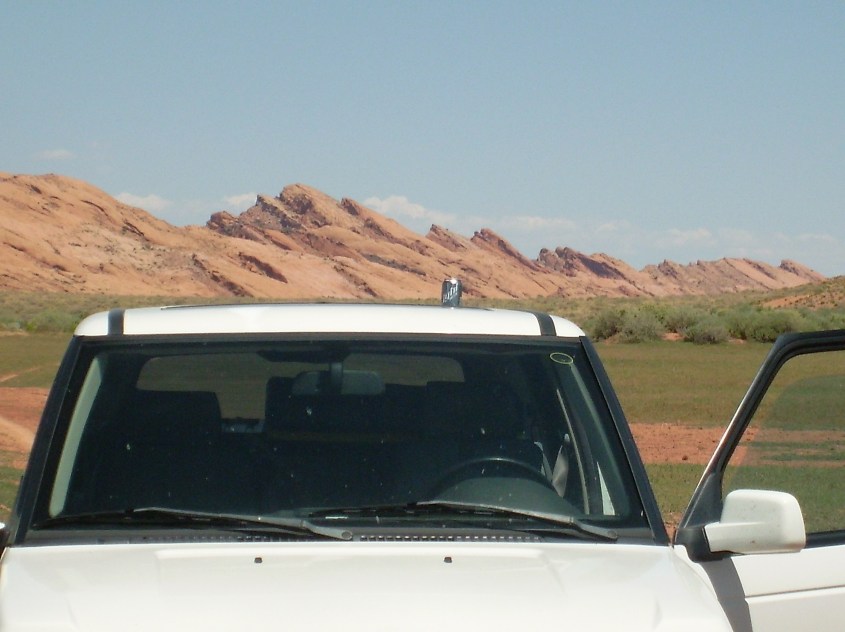
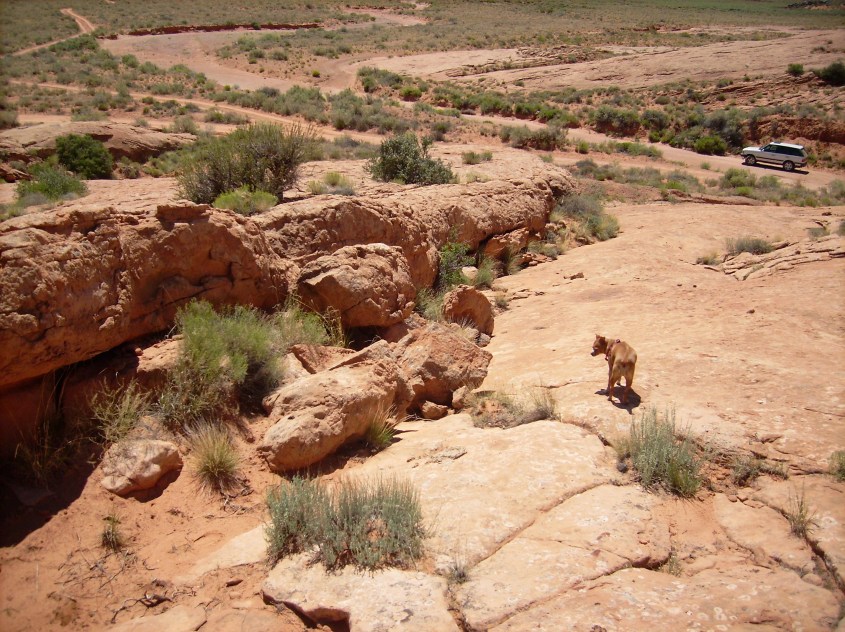






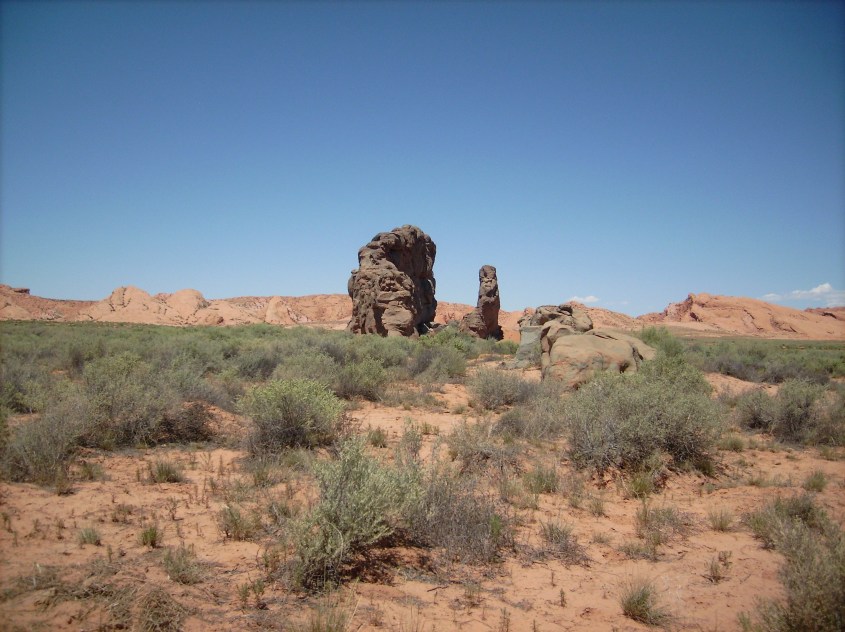
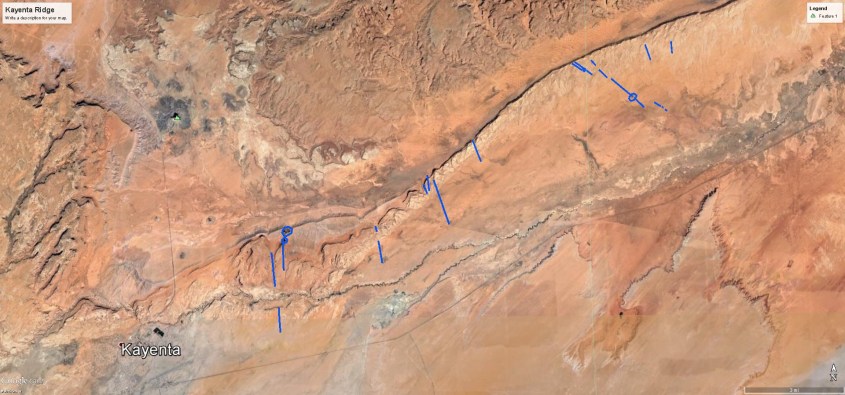
 Down river we drove, surveying each campsite along the way. Here, the river cuts through a deep walled chasm favored by rock climbers. So the camps were full of these spider people; a strange, underfed and insular cult, festooned with colorful webbing.
Down river we drove, surveying each campsite along the way. Here, the river cuts through a deep walled chasm favored by rock climbers. So the camps were full of these spider people; a strange, underfed and insular cult, festooned with colorful webbing. I watched the sun angle below canyon walls, wondering how long until it cooled inside the tent to be bearable. I paced back and forth in smoke to foil the mosquitoes, my skin cooking from fire, my insides cooking in vodka, and fever in my brain from both.
I watched the sun angle below canyon walls, wondering how long until it cooled inside the tent to be bearable. I paced back and forth in smoke to foil the mosquitoes, my skin cooking from fire, my insides cooking in vodka, and fever in my brain from both.






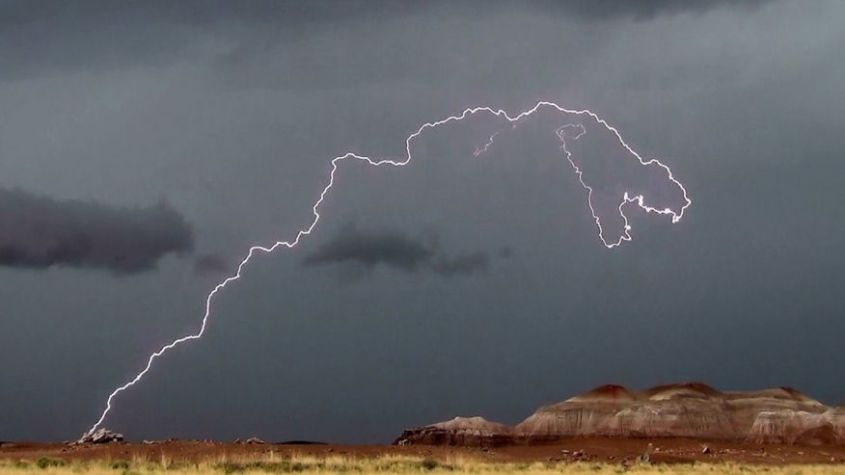

![IMG_1727[1]](https://thedailyplasma.blog/wp-content/uploads/2015/06/img_17271.jpg?w=845)
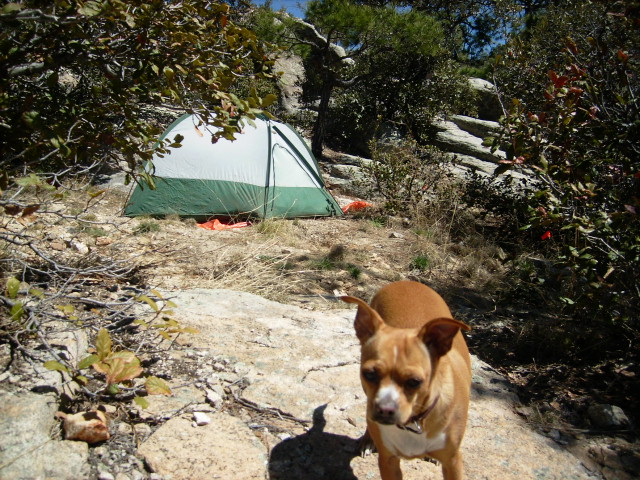
 Ginger and I traveled to a little known place in Arizona where the creatures are known to make an appearance now and then. I’m not saying where it is, but it’s a large mountain that looks like this one. We arrived and found a beautiful camp by the lake.
Ginger and I traveled to a little known place in Arizona where the creatures are known to make an appearance now and then. I’m not saying where it is, but it’s a large mountain that looks like this one. We arrived and found a beautiful camp by the lake. Soon after, Ginger crawled out of the sleeping bag and looked at the tent door. I thought she needed to potty, or get water, so I unzipped the tent. She immediately crouched low, dropped her ears and tail, and growled with deep, serious intent out the opening. She almost never growls and I’ve only heard her do that when fending off a mean dog, or one of the meth addicts in our neighborhood. I don’t know how she can tell a meth addict from anyone else. Same way we do, I guess, because they’re scary.
Soon after, Ginger crawled out of the sleeping bag and looked at the tent door. I thought she needed to potty, or get water, so I unzipped the tent. She immediately crouched low, dropped her ears and tail, and growled with deep, serious intent out the opening. She almost never growls and I’ve only heard her do that when fending off a mean dog, or one of the meth addicts in our neighborhood. I don’t know how she can tell a meth addict from anyone else. Same way we do, I guess, because they’re scary. We left on the fourth of July. This was strategic on two counts. First, all the holiday campers would be leaving that day and we like our solitude. Second, all the Bigfoot should be ready to raise hell now that the firework wielding, beer soaked campers were gone. We thought the Skeezamen ( a local name) might even venture to the lake now that it was quite after the long weekend. I can’t help but think that crawdads would be one of their favorite snacks – its one of mine.
We left on the fourth of July. This was strategic on two counts. First, all the holiday campers would be leaving that day and we like our solitude. Second, all the Bigfoot should be ready to raise hell now that the firework wielding, beer soaked campers were gone. We thought the Skeezamen ( a local name) might even venture to the lake now that it was quite after the long weekend. I can’t help but think that crawdads would be one of their favorite snacks – its one of mine.



 Ginger and I scouted several areas where the trees seemed arranged non-randomly. There were several areas where there were these crosses formed from broken tree trunks. They faced the road squarely with lots of other disturbance around them; a profusion of broken limbs, stumps and trunks leaning against other trees.
Ginger and I scouted several areas where the trees seemed arranged non-randomly. There were several areas where there were these crosses formed from broken tree trunks. They faced the road squarely with lots of other disturbance around them; a profusion of broken limbs, stumps and trunks leaning against other trees.




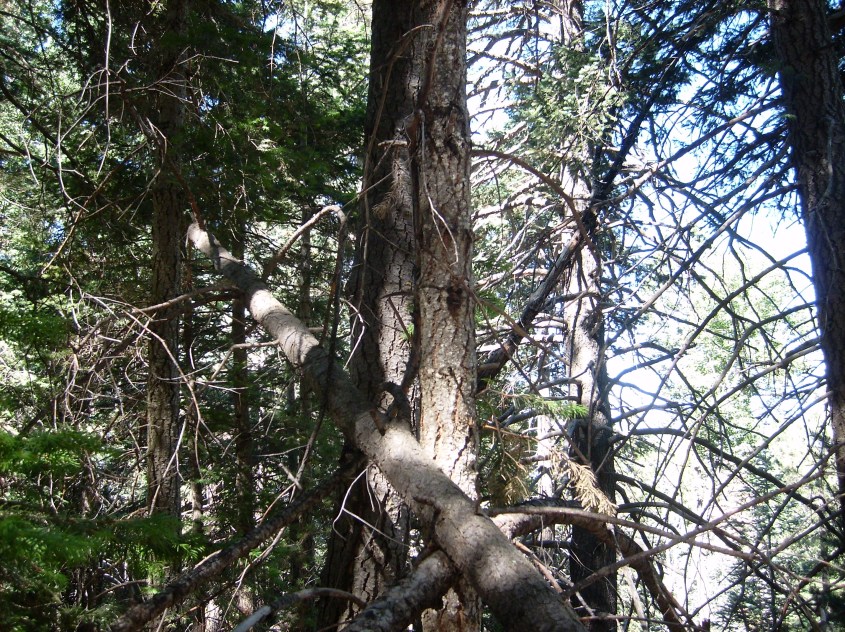
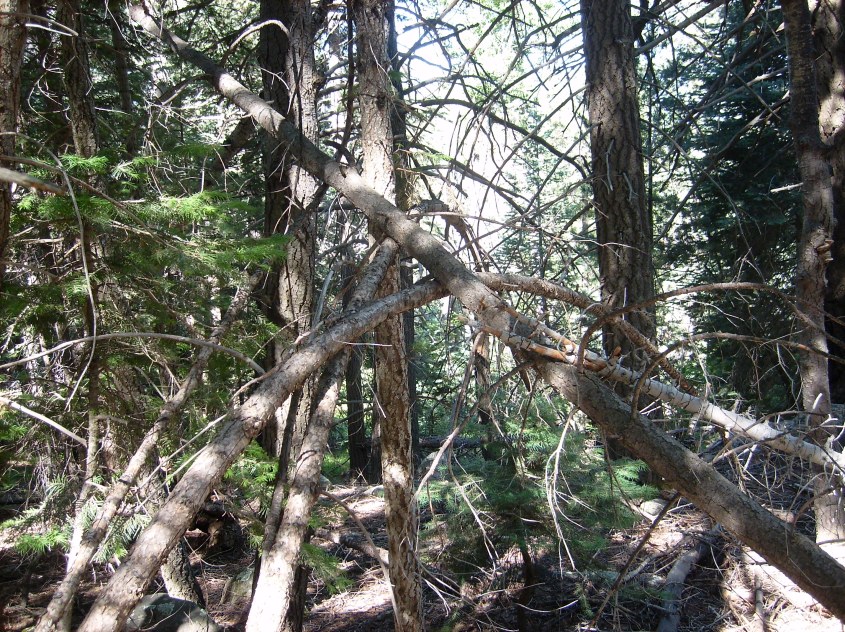
 There are two trees still rooted and bent over in arches, another laid over in the same direction and one pressed against the trunk of the center tree like a spring. Two logs are laid over all four to hold them down. Well, it seems odd to me. Ginger wouldn’t get out of the car. She was bored with tree structures.
There are two trees still rooted and bent over in arches, another laid over in the same direction and one pressed against the trunk of the center tree like a spring. Two logs are laid over all four to hold them down. Well, it seems odd to me. Ginger wouldn’t get out of the car. She was bored with tree structures. I suppose this could have fallen in a wind this way. If it was the only one like it I would even assume so, but there are several broken, bent or wedged in improbable positions like this in clusters. Note all the other leaning trees nearby. Here are more views of the same trees.
I suppose this could have fallen in a wind this way. If it was the only one like it I would even assume so, but there are several broken, bent or wedged in improbable positions like this in clusters. Note all the other leaning trees nearby. Here are more views of the same trees.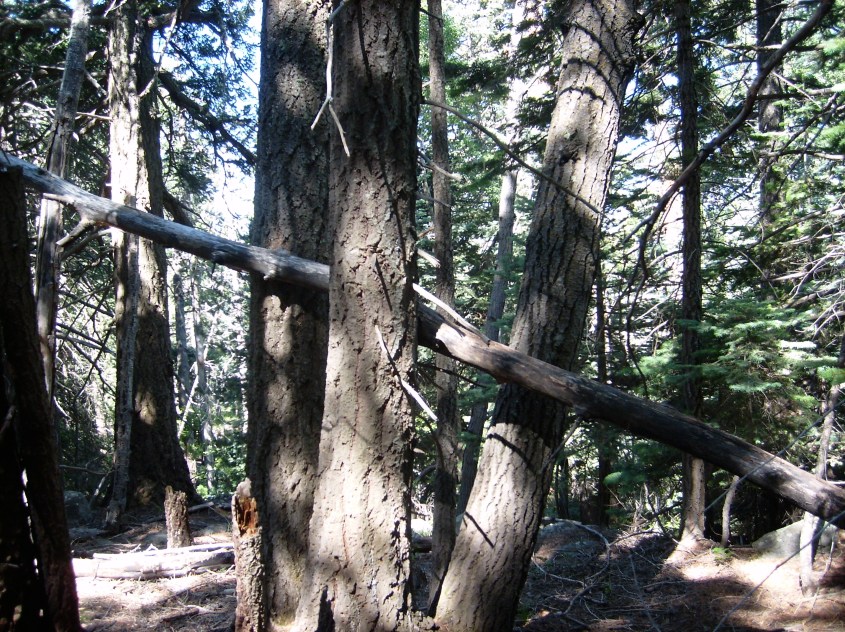
 Ginger was getting annoyed I was looking at trees. She wanted to look for Bigfoot. She doesn’t make the connection with trees because she’s a dog. Dogs don’t look up. If it had been a turd on the ground, or something fun to pee on, she’d have been more interested.
Ginger was getting annoyed I was looking at trees. She wanted to look for Bigfoot. She doesn’t make the connection with trees because she’s a dog. Dogs don’t look up. If it had been a turd on the ground, or something fun to pee on, she’d have been more interested. Notice how the leaning trees are held down by the broken tree? They should not have been in the line of fall if this had been wind or snow. That’s how they always seem to fall in this particular area though.
Notice how the leaning trees are held down by the broken tree? They should not have been in the line of fall if this had been wind or snow. That’s how they always seem to fall in this particular area though. Ginger and I are very attached. She’s a weird dog, but also the smartest, warmest dog I’ve ever known. By warm, I mean warm. Mexican aristocrats bred Chihuahuas to sleep with because they were better than hot water bottles. This is how we sleep, with her curled against my back to keep us warm.
Ginger and I are very attached. She’s a weird dog, but also the smartest, warmest dog I’ve ever known. By warm, I mean warm. Mexican aristocrats bred Chihuahuas to sleep with because they were better than hot water bottles. This is how we sleep, with her curled against my back to keep us warm. I don’t know where she slept that night. One camper who I’d talked to flagged me down as I left the campground and asked if I’d found her. He said she had approached his camp just after I’d been by earlier and he was looking to tell me. I said, thanks she was with me now and wondered from which direction she’d come. He pointed to the opposite side of the lake from the campground.
I don’t know where she slept that night. One camper who I’d talked to flagged me down as I left the campground and asked if I’d found her. He said she had approached his camp just after I’d been by earlier and he was looking to tell me. I said, thanks she was with me now and wondered from which direction she’d come. He pointed to the opposite side of the lake from the campground.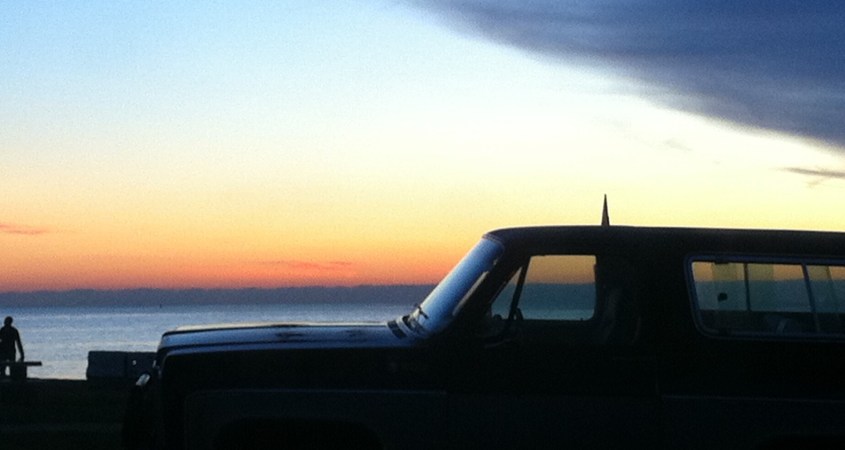
 This was to be my first EU conference. As I left Tucson on I-10, the temperature was hot. Arizona in June is like Venus. Temperatures always hover above 100ºF, but when it exceeds 110ºF, it’s life threatening.
This was to be my first EU conference. As I left Tucson on I-10, the temperature was hot. Arizona in June is like Venus. Temperatures always hover above 100ºF, but when it exceeds 110ºF, it’s life threatening. Susan introduced me to the EU. I found Thunderbolts while surfing the web, became convinced for reasons too numerous to get into now and contacted Susan to pitch a guest blog. Susan gave me that opportunity and made everything else happen. I simply had to write what I learned and she handled the rest. Susan is the engine of Thunderbolts, but made time to make sure I was taken care of.
Susan introduced me to the EU. I found Thunderbolts while surfing the web, became convinced for reasons too numerous to get into now and contacted Susan to pitch a guest blog. Susan gave me that opportunity and made everything else happen. I simply had to write what I learned and she handled the rest. Susan is the engine of Thunderbolts, but made time to make sure I was taken care of. Every Leo was different. Every Leo was interesting. Every Leo is my brother and sister, now, but that is getting ahead of the story. Leo came from British Columbia, Montreal, New Brunswick, Colorado, California, UK, Australia, Belarus, Germany, Tibet and at least one from another planet. Leo wore tattoos and buzz cuts; tie-dyeds and chinos; safari hats and bandanas; piercings and goatees; or in one case, a beaded, braided fu-manchu. All points on the globe, all types of people, representing a common interest in our Electric Universe.
Every Leo was different. Every Leo was interesting. Every Leo is my brother and sister, now, but that is getting ahead of the story. Leo came from British Columbia, Montreal, New Brunswick, Colorado, California, UK, Australia, Belarus, Germany, Tibet and at least one from another planet. Leo wore tattoos and buzz cuts; tie-dyeds and chinos; safari hats and bandanas; piercings and goatees; or in one case, a beaded, braided fu-manchu. All points on the globe, all types of people, representing a common interest in our Electric Universe. The young couple left. I don’t think they understood UK Leo either. He and I talked nonsense through our beers and then I left to circulate. At the bar I spotted Southern Comfort Leo. Southern Comfort Leo was someone I wanted to get to know, because I’d seen him present in a video of the previous year’s EU conference. His topic had direct bearing on mine. He held court at the corner of the bar, a place only a talkative person would take.
The young couple left. I don’t think they understood UK Leo either. He and I talked nonsense through our beers and then I left to circulate. At the bar I spotted Southern Comfort Leo. Southern Comfort Leo was someone I wanted to get to know, because I’d seen him present in a video of the previous year’s EU conference. His topic had direct bearing on mine. He held court at the corner of the bar, a place only a talkative person would take. As I found with all EU conference participants, they are fiercely independent thinkers who fear no topic. In this case, our conversation turned to God and the relative merits of belief in HIS existence. Dangerous ground for a late night at the bar.
As I found with all EU conference participants, they are fiercely independent thinkers who fear no topic. In this case, our conversation turned to God and the relative merits of belief in HIS existence. Dangerous ground for a late night at the bar. The conference room was a comfortable place. Dark, with a casual and attentive audience and the most interesting subjects to hear about, delivered by some of the most knowledgeable people in the world. What could be better. I lost myself in the ambience, surprisingly relaxed, without any building apprehension for my own talk that afternoon.
The conference room was a comfortable place. Dark, with a casual and attentive audience and the most interesting subjects to hear about, delivered by some of the most knowledgeable people in the world. What could be better. I lost myself in the ambience, surprisingly relaxed, without any building apprehension for my own talk that afternoon. After dinner, of course, Rich and I retired to the bar, while the sensible people went about other business, like sleep. After one drink, my brother left to meet his son in Scottsdale, leaving me with the Leo’s again. It was pretty much the same crew, UK Leo, Southern Comfort Leo, Roommate Leo and me. Many other Leos were there, too.
After dinner, of course, Rich and I retired to the bar, while the sensible people went about other business, like sleep. After one drink, my brother left to meet his son in Scottsdale, leaving me with the Leo’s again. It was pretty much the same crew, UK Leo, Southern Comfort Leo, Roommate Leo and me. Many other Leos were there, too. The day had been hot and it began to take its toll. People drifted away to bed, leaving only dead-enders. You know us by now. Leo and I had both shifted from beer to vodka at this point, so my recollection may be out of sequence. What I recall is that Leo began speaking gibberish.
The day had been hot and it began to take its toll. People drifted away to bed, leaving only dead-enders. You know us by now. Leo and I had both shifted from beer to vodka at this point, so my recollection may be out of sequence. What I recall is that Leo began speaking gibberish.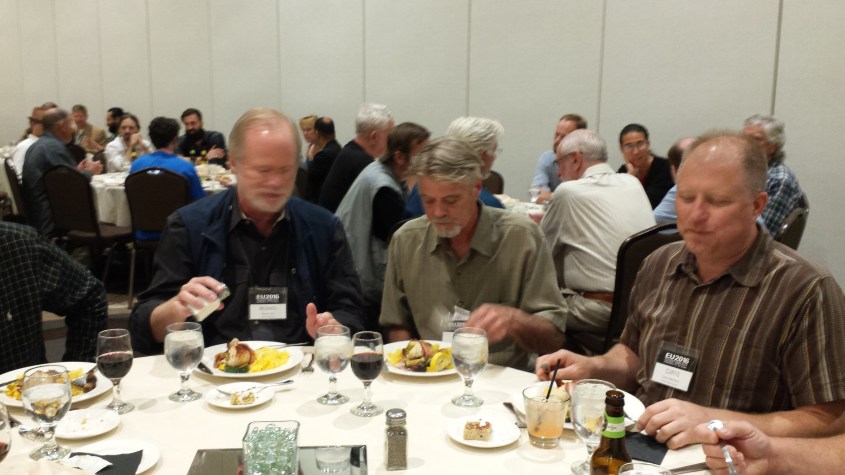 After the banquet there was a gathering at the bar. I happened to join in. Imagine that… Leo was there, too. All of the Leos, in fact. This was the big finale. It wound down as the sun rose and it was too late, or perhaps too early…whatever, to buy beer at the Circle K. I spent my time engrossed in conversation with a charming Leo from UK, this one a female, about documentary film making.
After the banquet there was a gathering at the bar. I happened to join in. Imagine that… Leo was there, too. All of the Leos, in fact. This was the big finale. It wound down as the sun rose and it was too late, or perhaps too early…whatever, to buy beer at the Circle K. I spent my time engrossed in conversation with a charming Leo from UK, this one a female, about documentary film making. There is a mathematical rule that relates the number of people in a party to the time it takes that party to actually do anything. It is called the ‘milling factor’. The more people there are, the larger the milling factor becomes by logarithmic scale. If there are enough people, the milling factor will prevent anything from happening and the situation devolves to chaos. With well over twenty people the milling factor was enormous.
There is a mathematical rule that relates the number of people in a party to the time it takes that party to actually do anything. It is called the ‘milling factor’. The more people there are, the larger the milling factor becomes by logarithmic scale. If there are enough people, the milling factor will prevent anything from happening and the situation devolves to chaos. With well over twenty people the milling factor was enormous. Some folks refer to this as ‘herding cats’. I disagree. Cats tend to scatter and move. High milling factor creates a kind of paralysis where people just stand and stare at each other, waiting for someone else to make a move. Milling has a more bovine nature to it. My BIG coffee was almost finished when the vans actually started rolling. Now I had to pee. I held on because I wasn’t about to run inside when everyone else was finally ready, so we took off on the Geology tour.
Some folks refer to this as ‘herding cats’. I disagree. Cats tend to scatter and move. High milling factor creates a kind of paralysis where people just stand and stare at each other, waiting for someone else to make a move. Milling has a more bovine nature to it. My BIG coffee was almost finished when the vans actually started rolling. Now I had to pee. I held on because I wasn’t about to run inside when everyone else was finally ready, so we took off on the Geology tour. He was bundled in the back of a van to re-hydrate and sleep, while someone else took over command of his car, now driving on a spare. We spent a couple of hours getting a new tire for Leo in-the-car-ahead and ended up split into two groups somewhere in Verde Valley because of lunch preferences. We regrouped in Oak Creek Canyon, just past Sedona. Here, everyone cooled their feet in the water under the shade of cottonwoods at Oak Creek’s shore.
He was bundled in the back of a van to re-hydrate and sleep, while someone else took over command of his car, now driving on a spare. We spent a couple of hours getting a new tire for Leo in-the-car-ahead and ended up split into two groups somewhere in Verde Valley because of lunch preferences. We regrouped in Oak Creek Canyon, just past Sedona. Here, everyone cooled their feet in the water under the shade of cottonwoods at Oak Creek’s shore. After that first devastating day of heat, others began to notice – in addition to how bad I smelled – how I always parked in shade if I could find it, or aim the car away from the sun so the seats didn’t blister my ass when I got back in. At 120ºF, a car’s interior surfaces exposed to sun can reach 195ºF. By comparison, pork is considered safe to eat at 145ºF. I don’t comb my hair either, otherwise I’ll get a sunburned part. Tricks of the desert rat.
After that first devastating day of heat, others began to notice – in addition to how bad I smelled – how I always parked in shade if I could find it, or aim the car away from the sun so the seats didn’t blister my ass when I got back in. At 120ºF, a car’s interior surfaces exposed to sun can reach 195ºF. By comparison, pork is considered safe to eat at 145ºF. I don’t comb my hair either, otherwise I’ll get a sunburned part. Tricks of the desert rat. Michael understood and looked at landscape in a way no one else had really captured. His inspirations inspired many more. We came to spread his ashes at the Southern Rim of the Grand Canyon. Herr Leo had selected Geology Point as an appropriate place. It was.
Michael understood and looked at landscape in a way no one else had really captured. His inspirations inspired many more. We came to spread his ashes at the Southern Rim of the Grand Canyon. Herr Leo had selected Geology Point as an appropriate place. It was. I spoke with Michael’s friends about the formation of the Grand Canyon. I agree with Michael’s assessment, in general. The canyon was carved by an explosive current locked to the river’s channel. I’d looked into, and written about breccia pipes; karst-like formations of broken rock that fill vertical tunnels emanating from a limestone formation above the inner gorge. These breccia pipes emerge from the ground all over the south rim, concentrated along the rim and even split open in places along the canyon wall.
I spoke with Michael’s friends about the formation of the Grand Canyon. I agree with Michael’s assessment, in general. The canyon was carved by an explosive current locked to the river’s channel. I’d looked into, and written about breccia pipes; karst-like formations of broken rock that fill vertical tunnels emanating from a limestone formation above the inner gorge. These breccia pipes emerge from the ground all over the south rim, concentrated along the rim and even split open in places along the canyon wall. We crossed the Little Colorado and skirted the Navajo Nation, heading north. At Cameron, Arizona we stopped for lunch. It made sense, since one of our Leo’s was named Cameran-Leo; wrong spelling, but close enough to earn a sandwich. This was also where I departed, leaving to drive home to Tucson through the best part of Arizona, Highway 191. I’ll tell about that in a moment.
We crossed the Little Colorado and skirted the Navajo Nation, heading north. At Cameron, Arizona we stopped for lunch. It made sense, since one of our Leo’s was named Cameran-Leo; wrong spelling, but close enough to earn a sandwich. This was also where I departed, leaving to drive home to Tucson through the best part of Arizona, Highway 191. I’ll tell about that in a moment. As the StRange Rover hummed along, the sun began to set on a landscape I could only imagine had been etched. Magnificent undulating, layered and cap-rocked dunes scalloped and gouged around the edges. A different electrical scarring than I’d been studying. Something to look into in the future.
As the StRange Rover hummed along, the sun began to set on a landscape I could only imagine had been etched. Magnificent undulating, layered and cap-rocked dunes scalloped and gouged around the edges. A different electrical scarring than I’d been studying. Something to look into in the future. Near Kayenta is where Dave Talbott’s photo of a petroglyph was taken. The one Tony Perratt identified as a plasma instability – rock hard evidence of an aurora in the ancient sky that our ancestors witnessed. I marveled to myself that his paper had been published over a decade ago and so few people had even noticed. Yet it gave up so much truth. It was the very thing that had brought me to look into EU.
Near Kayenta is where Dave Talbott’s photo of a petroglyph was taken. The one Tony Perratt identified as a plasma instability – rock hard evidence of an aurora in the ancient sky that our ancestors witnessed. I marveled to myself that his paper had been published over a decade ago and so few people had even noticed. Yet it gave up so much truth. It was the very thing that had brought me to look into EU. They were either hiding from something from above, or below – lightning perhaps, or a swarm of hungry bigfoot (cannibal demons in the native Hopi) come down from the San Juan’s. I don’t know which yet, but I’m going to Tsegi some day to figure it out and write a novel about it.
They were either hiding from something from above, or below – lightning perhaps, or a swarm of hungry bigfoot (cannibal demons in the native Hopi) come down from the San Juan’s. I don’t know which yet, but I’m going to Tsegi some day to figure it out and write a novel about it. After a night in a cheap motel along I-40, where I closed thick drapes and slept late, I departed on my final day. This I knew would be an epic drive. Highway 191 (renamed because Highway 666 seemed to disturb some people) runs down the eastern edge of the State. It is an age-old corridor for migration and trade. The Anasazi traded with the Aztecs along this route. It led to the region’s giant center of trade, Chaco Canyon. The Puebloans retreated on this route during the diaspora.
After a night in a cheap motel along I-40, where I closed thick drapes and slept late, I departed on my final day. This I knew would be an epic drive. Highway 191 (renamed because Highway 666 seemed to disturb some people) runs down the eastern edge of the State. It is an age-old corridor for migration and trade. The Anasazi traded with the Aztecs along this route. It led to the region’s giant center of trade, Chaco Canyon. The Puebloans retreated on this route during the diaspora.
 A few miles further up the road, I passed volcanic cinder cones and rode over vast lava flows. On the lava flows, lightning began to strike. It flashed with an almost constant frequency, close enough to hear the peel of thunder, but far enough to enjoy the show. I pulled to the side on a hill and lowered my tailgate to watch – the reason I drive the StRange Rover is it has a classic drop-down tailgate – essential for such moments. I also celebrated Michael’s green thumb again as I watched the lightning strike and listened to the thunder. It was a fitting spectacle to end the journey and my formal introduction to the Electric Universe.
A few miles further up the road, I passed volcanic cinder cones and rode over vast lava flows. On the lava flows, lightning began to strike. It flashed with an almost constant frequency, close enough to hear the peel of thunder, but far enough to enjoy the show. I pulled to the side on a hill and lowered my tailgate to watch – the reason I drive the StRange Rover is it has a classic drop-down tailgate – essential for such moments. I also celebrated Michael’s green thumb again as I watched the lightning strike and listened to the thunder. It was a fitting spectacle to end the journey and my formal introduction to the Electric Universe. Update: Leo is now engaged to Leo. I have confirmation, so feel free to announce it. And I thought I was having fun…apparently not as much as those two.
Update: Leo is now engaged to Leo. I have confirmation, so feel free to announce it. And I thought I was having fun…apparently not as much as those two.
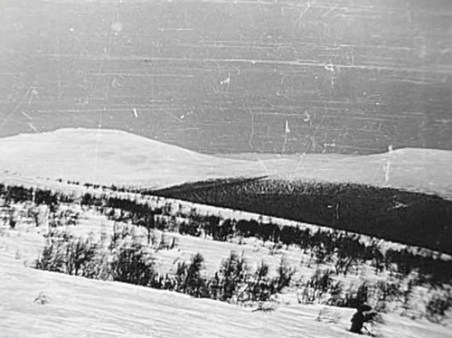
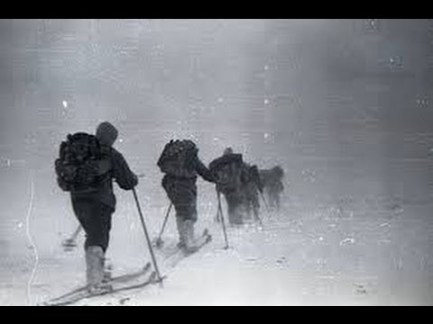
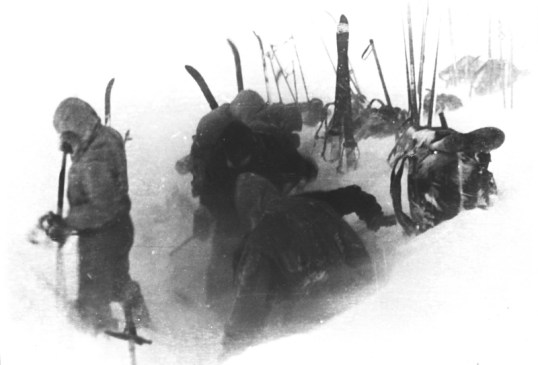



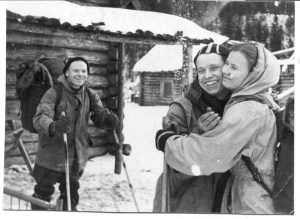
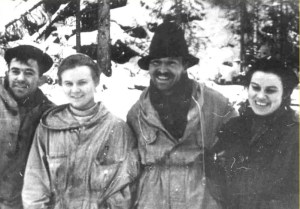



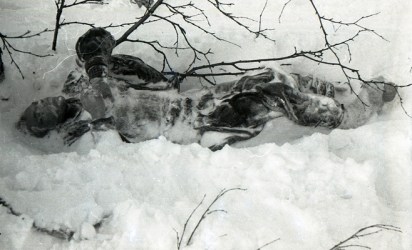
![Dyatloff_group_115_Kriv[1]](https://thecloakedhedgehog.files.wordpress.com/2013/06/dyatloff_group_115_kriv1.jpg?w=474)


![Dyatloff_group_115_Dor[1]](https://thecloakedhedgehog.files.wordpress.com/2013/06/dyatloff_group_115_dor1.jpg?w=474)
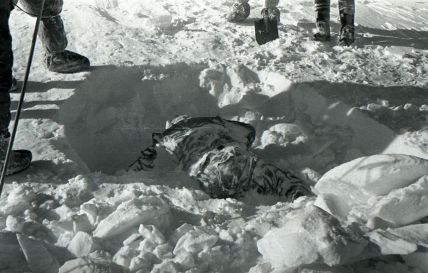

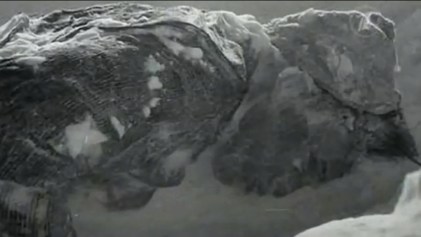
![Dyatloff_group_115_Sl[1]](https://thecloakedhedgehog.files.wordpress.com/2013/06/dyatloff_group_115_sl1.jpg?w=474)
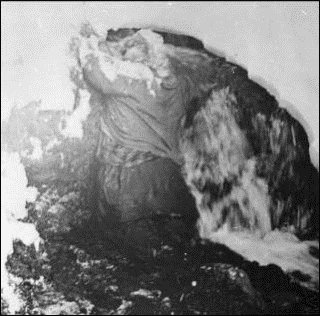
![0_50713_afe7198b_M[1]](https://thecloakedhedgehog.files.wordpress.com/2013/06/0_50713_afe7198b_m1.gif?w=164&h=239)
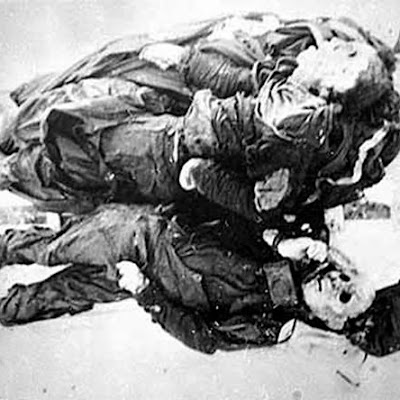
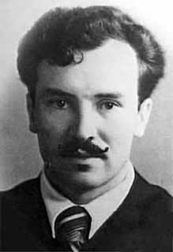
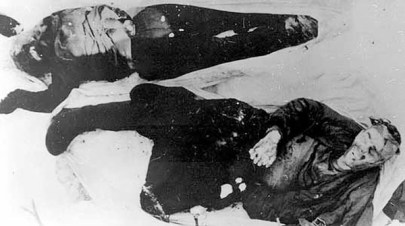
![Dyatloff_group_115_Kolev[1]](https://thecloakedhedgehog.files.wordpress.com/2013/06/dyatloff_group_115_kolev1.jpg?w=164&h=249)
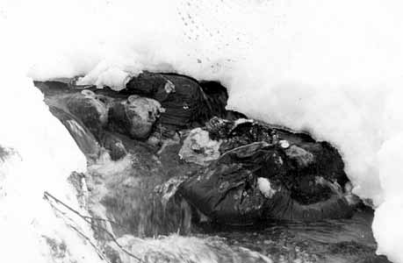
![i_010[1]](https://thecloakedhedgehog.files.wordpress.com/2013/06/i_0101.jpg?w=165&h=208)
